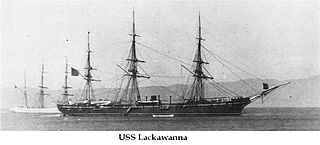
USS Brooklyn (1858) was a sloop-of-war authorized by the U.S. Congress and commissioned in 1859. Brooklyn was active in Caribbean operations until the start of the American Civil War at which time she became an active participant in the Union blockade of the Confederate States of America.
The first USS Arizona was an iron-hulled, side-wheel merchant steamship. Seized by the Confederate States of America in 1862 during the American Civil War, she was captured later the same year by the United States Navy.
USS New London (1859) was a screw steamer of the Union Navy during the American Civil War. She was outfitted with a Parrott rifle and 32-pounders, and was assigned as a gunboat in the Union blockade of the Confederate States of America.

The Confederate blockade runner CSSFlorida, built at Greenpoint, New York in 1859, was thrice considered for a gunboat before she became one. Contrary to previous interpretation of the official records, closer comparison of entries reveals that she did not serve the Mississippi River Defense Fleet as originally intended but became a Government-owned blockade runner; most authors have confused her with the Mobilian CSS Florida who did not receive her name CSS Selma until July 1862. CSS Florida of New Orleans was one of 14 steamers of Charles Morgan's Southern Steamship Co. which Major General Mansfield Lovell "impressed for public service" at New Orleans, January 15, 1862, acting on Confederate Secretary of War Judah P. Benjamin's orders.

USS Sciota was a Unadilla-class gunboat built on behalf of the United States Navy for service during the Civil War. She was outfitted as a gunboat, with both a 20-pounder rifle for horizontal firing, and two howitzers for shore bombardment, and assigned to the Union blockade of the waterways of the Confederate States of America.

The first USS Lackawanna was a screw-propelled sloop-of-war in the Union Navy during the American Civil War.

The first USS Seminole was a steam sloop-of-war in the United States Navy during the American Civil War.

USS Kennebec was a Unadilla-class gunboat built for the U.S. Navy following the outbreak of the American Civil War. She was named for the Kennebec River.
The second Navy vessel to bear the name Sachem, this screw steamer was built in 1844 at New York City, where it was purchased by the Navy on 20 September 1861.
USS Itasca was a Unadilla-class gunboat built for the U.S. Navy during the American Civil War. She was used by the Navy to patrol navigable waterways of the Confederacy to prevent the South from trading with other countries.
USS Two Sisters (1856) was a small 54-ton captured Confederate schooner acquired by the Union Navy from the prize court during the American Civil War.
USS Ariel (1862) was a captured Confederate schooner acquired by the Union Navy from the prize court during the American Civil War. She was put into service by the Union Navy to patrol navigable waterways of the Confederacy to prevent the South from trading with other countries.
USS Nita (1856) was a captured Confederate steamer acquired by the Union Navy from the prize court during the American Civil War. She was put into service by the Union Navy to patrol navigable waterways of the Confederacy to prevent the South from trading with other countries.
USS William G. Anderson (1859) was a barque used by the Union Navy during the American Civil War. She was assigned by the Navy to patrol navigable waterways of the Confederacy to prevent the South from trading with other countries.

USS Aroostook was a Unadilla-class gunboat built for the Union Navy during the American Civil War. Aroostook was used by the Navy to patrol navigable waterways of the Confederacy to prevent the South from trading with other countries.
USS Tioga (1862) was a large steamer with powerful guns, acquired by the Union Navy during the American Civil War.

USS Tahoma was a Unadilla-class gunboat built by order of the United States Navy for service during the American Civil War.
USS Antona (1863) was a steamer captured by the Union Navy during the American Civil War. She was used by the Union Navy as a dispatch boat and gunboat in support of the Union Navy blockade of the Confederate States of America.
The third USS Virginia was a 581-ton blockade-running steamer captured by the United States Navy and put to use by the Union Navy during the American Civil War. Virginia served the U.S. Navy primarily as a mortar gunboat. Her ordnance included six 24-pounder howitzers and a 12-pounder rifled gun.









